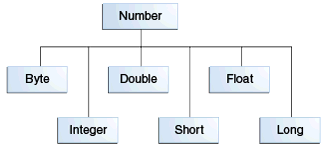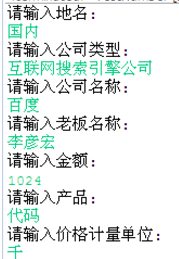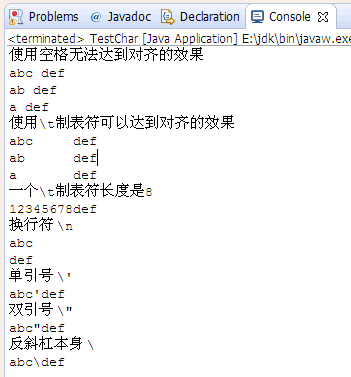字符串练习
字符串练习:装箱拆箱、字符串转换、数学方法、格式化输出、字符、字符串、操作字符串、比较字符串及Stringbuffer。
装箱拆箱
封装类
所有的基本类型,都有对应的类类型
比如int对应的类是Integer
这种类就叫做封装类
package digit;
public class TestNumber {
public static void main(String[] args) {
int i = 5;
//把一个基本类型的变量,转换为Integer对象
Integer it = new Integer(i);
//把一个Integer对象,转换为一个基本类型的int
int i2 = it.intValue();
}
}
Number类
数字封装类有
Byte,Short,Integer,Long,Float,Double
这些类都是抽象类Number的子类

package digit;
public class TestNumber {
public static void main(String[] args) {
int i = 5;
Integer it = new Integer(i);
//Integer是Number的子类,所以打印true
System.out.println(it instanceof Number);
}
}
基本类型转封装类
package digit;
public class TestNumber {
public static void main(String[] args) {
int i = 5;
//基本类型转换成封装类型
Integer it = new Integer(i);
}
}
封装类转基本类型
package digit;
public class TestNumber {
public static void main(String[] args) {
int i = 5;
//基本类型转换成封装类型
Integer it = new Integer(i);
//封装类型转换成基本类型
int i2 = it.intValue();
}
}
自动装箱
不需要调用构造方法,通过 = 符号自动把 基本类型 转换为 类类型 就叫装箱
package digit;
public class TestNumber {
public static void main(String[] args) {
int i = 5;
//基本类型转换成封装类型
Integer it = new Integer(i);
//自动转换就叫装箱
Integer it2 = i;
}
}
自动拆箱
不需要调用Integer的intValue方法,通过=就自动转换成int类型,就叫拆箱
package digit;
public class TestNumber {
public static void main(String[] args) {
int i = 5;
Integer it = new Integer(i);
//封装类型转换成基本类型
int i2 = it.intValue();
//自动转换就叫拆箱
int i3 = it;
}
}
int的最大值,最小值
int的最大值可以通过其对应的封装类Integer.MAX_VALUE获取
package digit;
public class TestNumber {
public static void main(String[] args) {
//int的最大值
System.out.println(Integer.MAX_VALUE);
//int的最小值
System.out.println(Integer.MIN_VALUE);
}
}
练习-装箱拆箱
对byte,short,float,double进行自动拆箱和自动装箱
byte和Integer之间能否进行自动拆箱和自动装箱
通过Byte获取byte的最大值
字符串转换
数字转字符串
方法1: 使用String类的静态方法valueOf
方法2: 先把基本类型装箱为对象,然后调用对象的toString
package digit;
public class TestNumber {
public static void main(String[] args) {
int i = 5;
//方法1
String str = String.valueOf(i);
//方法2
Integer it = i;
String str2 = it.toString();
}
}
字符串转数字
调用Integer的静态方法parseInt
package digit;
public class TestNumber {
public static void main(String[] args) {
String str = "999";
int i= Integer.parseInt(str);
System.out.println(i);
}
}
练习-字符串转换
参考上述步骤
把浮点数 3.14 转换为 字符串 "3.14"
再把字符串 “3.14” 转换为 浮点数 3.14
如果字符串是 3.1a4,转换为浮点数会得到什么?
数学方法
java.lang.Math提供了一些常用的数学运算方法,并且都是以静态方法的形式存在
四舍五入, 随机数,开方,次方,π,自然常数
package digit;
public class TestNumber {
public static void main(String[] args) {
float f1 = 5.4f;
float f2 = 5.5f;
//5.4四舍五入即5
System.out.println(Math.round(f1));
//5.5四舍五入即6
System.out.println(Math.round(f2));
//得到一个0-1之间的随机浮点数(取不到1)
System.out.println(Math.random());
//得到一个0-10之间的随机整数 (取不到10)
System.out.println((int)( Math.random()*10));
//开方
System.out.println(Math.sqrt(9));
//次方(2的4次方)
System.out.println(Math.pow(2,4));
//π
System.out.println(Math.PI);
//自然常数
System.out.println(Math.E);
}
}
练习-数学方法
这个图是自然对数的计算方式。
借助Math的方法,把自然对数计算出来,看看经过自己计算的自然对数和Math.E的区别有多大
格式化输出
1:格式化输出
如果不使用格式化输出,就需要进行字符串连接,如果变量比较多,拼接就会显得繁琐
使用格式化输出,就可以简洁明了
%s 表示字符串
%d 表示数字
%n 表示换行
package digit;
public class TestNumber {
public static void main(String[] args) {
String name ="盖伦";
int kill = 8;
String title="超神";
//直接使用+进行字符串连接,编码感觉会比较繁琐,并且维护性差,易读性差
String sentence = name+ " 在进行了连续 " + kill + " 次击杀后,获得了 " + title +" 的称号";
System.out.println(sentence);
//使用格式化输出
//%s表示字符串,%d表示数字,%n表示换行
String sentenceFormat ="%s 在进行了连续 %d 次击杀后,获得了 %s 的称号%n";
System.out.printf(sentenceFormat,name,kill,title);
}
}
2:printf和format
printf和format能够达到一模一样的效果
package digit;
public class TestNumber {
public static void main(String[] args) {
String name ="盖伦";
int kill = 8;
String title="超神";
String sentenceFormat ="%s 在进行了连续 %d 次击杀后,获得了 %s 的称号%n";
//使用printf格式化输出
System.out.printf(sentenceFormat,name,kill,title);
//使用format格式化输出
System.out.format(sentenceFormat,name,kill,title);
}
}
3:换行符
换行符就是另起一行 --- '\n' 换行(newline)
回车符就是回到一行的开头 --- '\r' 回车(return)
在eclipse里敲一个回车,实际上是回车换行符
Java是跨平台的编程语言,同样的代码,可以在不同的平台使用,比如Windows,Linux,Mac
然而在不同的操作系统,换行符是不一样的
(1)在DOS和Windows中,每行结尾是 “\r\n”;
(2)Linux系统里,每行结尾只有 “\n”;
(3)Mac系统里,每行结尾是只有 "\r"。
为了使得同一个java程序的换行符在所有的操作系统中都有一样的表现,使用%n,就可以做到平台无关的换行
package digit;
public class TestNumber {
public static void main(String[] args) {
System.out.printf("这是换行符%n");
System.out.printf("这是换行符%n");
}
}
4 : 总长度,左对齐,补0,千位分隔符,小数点位数,本地化表达
其他常用的格式化方式
package digit;
import java.util.Locale;
public class TestNumber {
public static void main(String[] args) {
int year = 2020;
//总长度,左对齐,补0,千位分隔符,小数点位数,本地化表达
//直接打印数字
System.out.format("%d%n",year);
//总长度是8,默认右对齐
System.out.format("%8d%n",year);
//总长度是8,左对齐
System.out.format("%-8d%n",year);
//总长度是8,不够补0
System.out.format("%08d%n",year);
//千位分隔符
System.out.format("%,8d%n",year*10000);
//小数点位数
System.out.format("%.2f%n",Math.PI);
//不同国家的千位分隔符
System.out.format(Locale.FRANCE,"%,.2f%n",Math.PI*10000);
System.out.format(Locale.US,"%,.2f%n",Math.PI*10000);
System.out.format(Locale.UK,"%,.2f%n",Math.PI*10000);
}
}
5:Scanner
借助 Scanner 读取字符串数据,然后用格式化输出任意一段文字,类似以下

字符
保存一个字符的时候使用char
package character;
public class TestChar {
public static void main(String[] args) {
char c1 = 'a';
char c2 = '1';//字符1,而非数字1
char c3 = '中';//汉字字符
char c4 = 'ab'; //只能放一个字符
}
}
char对应的封装类
char对应的封装类是Character 装箱拆箱概念,参考 拆箱装箱
package character;
public class TestChar {
public static void main(String[] args) {
char c1 = 'a';
Character c = c1; //自动装箱
c1 = c;//自动拆箱
}
}
Character常见方法
package character;
public class TestChar {
public static void main(String[] args) {
System.out.println(Character.isLetter('a'));//判断是否为字母
System.out.println(Character.isDigit('a')); //判断是否为数字
System.out.println(Character.isWhitespace(' ')); //是否是空白
System.out.println(Character.isUpperCase('a')); //是否是大写
System.out.println(Character.isLowerCase('a')); //是否是小写
System.out.println(Character.toUpperCase('a')); //转换为大写
System.out.println(Character.toLowerCase('A')); //转换为小写
String a = 'a'; //不能够直接把一个字符转换成字符串
String a2 = Character.toString('a'); //转换为字符串
}
}
常见转义

package character;
public class TestChar {
public static void main(String[] args) {
System.out.println("使用空格无法达到对齐的效果");
System.out.println("abc def");
System.out.println("ab def");
System.out.println("a def");
System.out.println("使用\\t制表符可以达到对齐的效果");
System.out.println("abc\tdef");
System.out.println("ab\tdef");
System.out.println("a\tdef");
System.out.println("一个\\t制表符长度是8");
System.out.println("12345678def");
System.out.println("换行符 \\n");
System.out.println("abc\ndef");
System.out.println("单引号 \\'");
System.out.println("abc\'def");
System.out.println("双引号 \\\"");
System.out.println("abc\"def");
System.out.println("反斜杠本身 \\");
System.out.println("abc\\def");
}
}
练习-character
通过Scanner从控制台读取字符串,然后把字符串转换为字符数组
参考的转换方式:
String str = "abc123"; char[] cs = str.toCharArray();
转换为字符数组后,筛选出控制台读取到的字符串中的大写字母和数字,并打印出来
字符串
创建字符串
字符串即字符的组合,在Java中,字符串是一个类,所以我们见到的字符串都是对象
常见创建字符串手段:
每当有一个字面值出现的时候,虚拟机就会创建一个字符串
调用String的构造方法创建一个字符串对象
通过+加号进行字符串拼接也会创建新的字符串对象
package character;
public class TestString {
public static void main(String[] args) {
String garen ="盖伦"; //字面值,虚拟机碰到字面值就会创建一个字符串对象
String teemo = new String("提莫"); //创建了两个字符串对象
char[] cs = new char[]{'崔','斯','特'};
String hero = new String(cs);// 通过字符数组创建一个字符串对象
String hero3 = garen + teemo;// 通过+加号进行字符串拼接
}
}
final
String 被修饰为final,所以是不能被继承的
代码比较复制代码
package character;
public class TestString {
public static void main(String[] args) {
MyString str = new MyString();
}
/*这里会报错,因为String不能被继承*/
static class MyString extends String{
}
}
immutable
immutable 是指不可改变的
比如创建了一个字符串对象
String garen ="盖伦";
不可改变的具体含义是指:
不能增加长度
不能减少长度
不能插入字符
不能删除字符
不能修改字符
一旦创建好这个字符串,里面的内容 永远 不能改变
package character;
public class TestString {
public static void main(String[] args) {
String garen ="盖伦";
}
}
字符串格式化
如果不使用字符串格式化,就需要进行字符串连接,如果变量比较多,拼接就会显得繁琐
使用字符串格式化,就可以简洁明了
package character;
public class TestString {
public static void main(String[] args) {
String name ="盖伦";
int kill = 8;
String title="超神";
//直接使用+进行字符串连接,编码感觉会比较繁琐,并且维护性差,易读性差
String sentence = name+ " 在进行了连续 " + kill + " 次击杀后,获得了 " + title +" 的称号";
System.out.println(sentence);
//格式化字符串
//%s表示字符串,%d表示数字,%n表示换行
String sentenceFormat ="%s 在进行了连续 %d 次击杀后,获得了 %s 的称号%n";
String sentence2 = String.format(sentenceFormat, name,kill,title);
System.out.println(sentence2);
}
}
字符串长度
length方法返回当前字符串的长度可以有长度为0的字符串,即空字符串
package character;
public class TestString {
public static void main(String[] args) {
String name ="盖伦";
System.out.println(name.length());
String unknowHero = "";
//可以有长度为0的字符串,即空字符串
System.out.println(unknowHero.length());
}
}
练习-长度是5的随机字符串
创建一个长度是5的随机字符串,随机字符有可能是数字,大写字母或者小写字母
给点提示 : 数字和字符之间可以通过互相转换
char c = 'A';
short s = (short) c;
通过这个手段就能够知道字符 a-z A-Z 0-9 所对应的数字的区间了
练习-长度是8的字符串数组
创建一个长度是8的字符串数组
使用8个长度是5的随机字符串初始化这个数组
对这个数组进行排序,按照每个字符串的首字母排序(无视大小写)
注1: 不能使用Arrays.sort() 要自己写
注2: 无视大小写,即 Axxxx 和 axxxxx 没有先后顺序
操作字符串
获取字符串
charAt(int index)获取指定位置的字符
package character;
public class TestString {
public static void main(String[] args) {
String sentence = "盖伦,在进行了连续8次击杀后,获得了 超神 的称号";
char c = sentence.charAt(0);
System.out.println(c);
}
}
获取对应的字符数组
toCharArray() 获取对应的字符数组
package character;
public class TestString {
public static void main(String[] args) {
String sentence = "盖伦,在进行了连续8次击杀后,获得了超神 的称号";
char[] cs = sentence.toCharArray(); //获取对应的字符数组
System.out.println(sentence.length() == cs.length);
}
}
截取子字符串
subString 截取子字符串
package character;
public class TestString {
public static void main(String[] args) {
String sentence = "盖伦,在进行了连续8次击杀后,获得了 超神 的称号";
//截取从第3个开始的字符串 (基0)
String subString1 = sentence.substring(3);
System.out.println(subString1);
//截取从第3个开始的字符串 (基0)
//到5-1的位置的字符串
//左闭右开
String subString2 = sentence.substring(3,5);
System.out.println(subString2);
}
}
分割
split 根据分隔符进行分隔
package character;
public class TestString {
public static void main(String[] args) {
String sentence = "盖伦,在进行了连续8次击杀后,获得了 超神 的称号";
//根据,进行分割,得到3个子字符串
String subSentences[] = sentence.split(",");
for (String sub : subSentences) {
System.out.println(sub);
}
}
}
去掉首位空格
trim 去掉首尾空格
package character;
public class TestString {
public static void main(String[] args) {
String sentence = " 盖伦,在进行了连续8次击杀后,获得了 超神 的称号 ";
System.out.println(sentence);
//去掉首尾空格
System.out.println(sentence.trim());
}
}
大小写
toLowerCase 全部变成小写
toUpperCase 全部变成大写
package character;
public class TestString {
public static void main(String[] args) {
String sentence = "Garen";
//全部变成小写
System.out.println(sentence.toLowerCase());
//全部变成大写
System.out.println(sentence.toUpperCase());
}
}
定位
indexOf 判断字符或者子字符串出现的位置
contains 是否包含子字符串
package character;
public class TestString {
public static void main(String[] args) {
String sentence = "盖伦,在进行了连续8次击杀后,获得了超神 的称号";
System.out.println(sentence.indexOf('8')); //字符第一次出现的位置
System.out.println(sentence.indexOf("超神")); //字符串第一次出现的位置
System.out.println(sentence.lastIndexOf("了")); //字符串最后出现的位置
System.out.println(sentence.indexOf(',',5)); //从位置5开始,出现的第一次,的位置
System.out.println(sentence.contains("击杀")); //是否包含字符串"击杀"
}
}
替换
replaceAll 替换所有的
replaceFirst 只替换第一个
package character;
public class TestString {
public static void main(String[] args) {
String sentence = "盖伦,在进行了连续8次击杀后,获得了超神 的称号";
String temp = sentence.replaceAll("击杀", "被击杀"); //替换所有的
temp = temp.replaceAll("超神", "超鬼");
System.out.println(temp);
temp = sentence.replaceFirst(",","");//只替换第一个
System.out.println(temp);
}
}
比较字符串
是否是同一个对象
str1和str2的内容一定是一样的!
但是,并不是同一个字符串对象
package character;
public class TestString {
public static void main(String[] args) {
String str1 = "the light";
String str2 = new String(str1);
//==用于判断是否是同一个字符串对象
System.out.println( str1 == str2);
}
}
是否是同一个对象-特例
str1 = "the light";
str3 = "the light";
一般说来,编译器每碰到一个字符串的字面值,就会创建一个新的对象
所以在第6行会创建了一个新的字符串"the light"
但是在第7行,编译器发现已经存在现成的"the light",那么就直接拿来使用,而没有进行重复创建
package character;
public class TestString {
public static void main(String[] args) {
String str1 = "the light";
String str3 = "the light";
System.out.println( str1 == str3);
}
}
内容是否相同
使用equals进行字符串内容的比较,必须大小写一致
equalsIgnoreCase,忽略大小写判断内容是否一致
package character;
public class TestString {
public static void main(String[] args) {
String str1 = "the light";
String str2 = new String(str1);
String str3 = str1.toUpperCase();
//==用于判断是否是同一个字符串对象
System.out.println( str1 == str2);
System.out.println(str1.equals(str2));//完全一样返回true
System.out.println(str1.equals(str3));//大小写不一样,返回false
System.out.println(str1.equalsIgnoreCase(str3));//忽略大小写的比较,返回true
}
}
是否以子字符串开始或者结束
startsWith //以...开始
endsWith //以...结束
package character;
public class TestString {
public static void main(String[] args) {
String str1 = "the light";
String start = "the";
String end = "Ight";
System.out.println(str1.startsWith(start));//以...开始
System.out.println(str1.endsWith(end));//以...结束
}
}
练习-长度是100的字符串数组
创建一个长度是100的字符串数组
使用长度是2的随机字符填充该字符串数组
统计这个字符串数组里重复的字符串有多少种

Stringbuffer
追加,删除,插入,反转
append追加
delete 删除
insert 插入
reverse 反转
package character;
public class TestString {
public static void main(String[] args) {
String str1 = "let there ";
StringBuffer sb = new StringBuffer(str1); //根据str1创建一个StringBuffer对象
sb.append("be light"); //在最后追加
System.out.println(sb);
sb.delete(4, 10);//删除4-10之间的字符
System.out.println(sb);
sb.insert(4, "there ");//在4这个位置插入 there
System.out.println(sb);
sb.reverse(); //反转
System.out.println(sb);
}
}
长度,容量
为什么StringBuffer可以变长?
和String内部是一个字符数组一样,StringBuffer也维护了一个字符数组。 但是,这个字符数组,留有冗余长度
比如说new StringBuffer("the"),其内部的字符数组的长度,是19,而不是3,这样调用插入和追加,在现成的数组的基础上就可以完成了。
如果追加的长度超过了19,就会分配一个新的数组,长度比原来多一些,把原来的数据复制到新的数组中,看上去 数组长度就变长了
length: “the”的长度 3
capacity: 分配的总空间 19
注: 19这个数量,不同的JDK数量是不一样的
package character;
public class TestString {
public static void main(String[] args) {
String str1 = "the";
StringBuffer sb = new StringBuffer(str1);
System.out.println(sb.length()); //内容长度
System.out.println(sb.capacity());//总空间
}
}
练习
String与StringBuffer的性能区别?
生成10位长度的随机字符串
然后,先使用String的+,连接10000个随机字符串,计算消耗的时间
然后,再使用StringBuffer连接10000个随机字符串,计算消耗的时间
提示: 使用System.currentTimeMillis() 获取当前时间(毫秒)

练习-StringBuffer
根据接口IStringBuffer ,自己做一个MyStringBuffer
package character;
public interface IStringBuffer {
public void append(String str); //追加字符串
public void append(char c); //追加字符
public void insert(int pos,char b); //指定位置插入字符
public void insert(int pos,String b); //指定位置插入字符串
public void delete(int start); //从开始位置删除剩下的
public void delete(int start,int end); //从开始位置删除结束位置-1
public void reverse(); //反转
public int length(); //返回长度
}
package character;
public class MyStringBuffer implements IStringBuffer{
}
